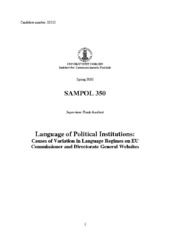| dc.contributor.author | Abrahamsen, Stian Reme | eng |
| dc.date.accessioned | 2010-09-14T08:42:26Z | |
| dc.date.available | 2010-09-14T08:42:26Z | |
| dc.date.issued | 2010-05-20 | eng |
| dc.date.submitted | 2010-05-20 | eng |
| dc.identifier.uri | https://hdl.handle.net/1956/4177 | |
| dc.description.abstract | Oppgaven handler om språkregimer på websidene til Kommissærer og Generaldirectorater i EU Kommisjonen. Det er svært ulik praksis hvordan man har strukturert siden for hver enkelt Kommisær og Generaldirektør. Oppgaven ønsker å finne ut årsaken til den store variasjonen av språkrgimer på websidene. Dette er gjort ved først estimere antall språk på alle websidene til hver enkelt kommissær og General Direktorat, før en regeresjonsanalyse blir gjennomført. Jeg har også gjort intervjuer av personnel i Kommisjonen. | en_US |
| dc.description.abstract | Committed to multilingualism, the Commission website struggles to be as multilingual as possible. However, different Commissioner (COMM) and Directorate General (DG) Websites engrafted in the Commission website create very different language regimes that lead to very unequal language availability. The underlying puzzle is the causes of variation in language availability on COMM and DG websites. Following Regulation No. 1 (Council of the European Community 1958), we would expect a coherent language regime between and within all units. However, both COMM and DG websites show substantial variation in language regimes, ranging from the use of one to 23 official member languages. Why are there differences in language availability within and between COMM and DG websites and between levels in website structures? The efficiency and commitment mechanisms are first discussed in state language development in general, before related to EU language regime formation. Several factors seem to trigger the efficiency and commitment mechanisms, forming language regimes of each unit website. Combining both quantitative and qualitative methods the analysis investigates the causes of variation in language regimes between COMM and DG websites. This is first done by measuring language availability on COMM and DG websites dividing the website structure into three levels C1-C3 that reveal COMM and DG website language regimes. Second, frequency histograms are used to capture different structures in Commissioner and Directorate General website language regimes at each website level. Then different regression models for COMM and DG websites at levels C1-C3 are modelled based on seven dimensins: Political-Bureaucratic, Culture, Generality, Dynamic-Static, Economy, Externality and World Language. Each variable are expected to have specific triggering effect on the efficiency and commitment mechanisms influencing COMM and DG website language regimes. Furthermore, interviews of Cabinet members of both COMMs and DGs are conducted investigating the reasons for choices made creating different website language regimes. Variables in the regression models are deduced from expectations based on theory together with information found in the interviews, thus the explorative character of the methods employed is visible. | en_US |
| dc.format.extent | 1272576 bytes | eng |
| dc.format.mimetype | application/pdf | eng |
| dc.language.iso | eng | eng |
| dc.publisher | The University of Bergen | eng |
| dc.title | Language of political institutions: Causes of variation in language regimes on EU Commissioner and Directorate general websites | eng |
| dc.type | Master thesis | en_US |
| dc.rights.holder | The author | en_US |
| dc.rights.holder | Copyright the author. All rights reserved | en_US |
| dc.description.degree | Master i Sammenliknende politikk | |
| dc.description.localcode | SAMPOL350 | |
| dc.description.localcode | MASV-SAPO | |
| dc.subject.nus | 731114 | eng |
| dc.subject.nsi | VDP::Samfunnsvitenskap: 200::Statsvitenskap og organisasjonsteori: 240::Sammenlignende politikk: 241 | nob |
| dc.subject.nsi | VDP::Humaniora: 000::Språkvitenskapelige fag: 010 | nob |
| fs.subjectcode | SAMPOL350 | |
